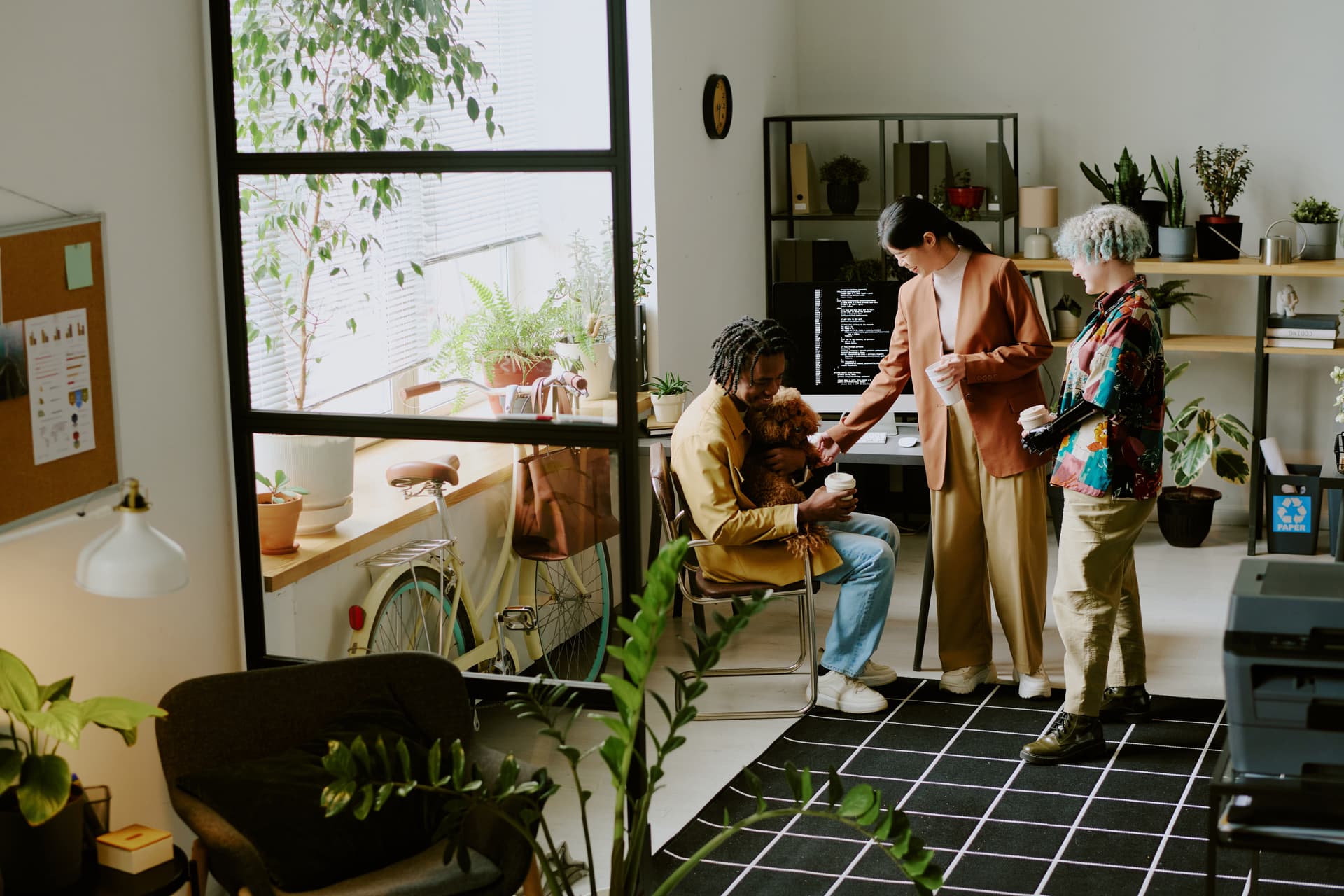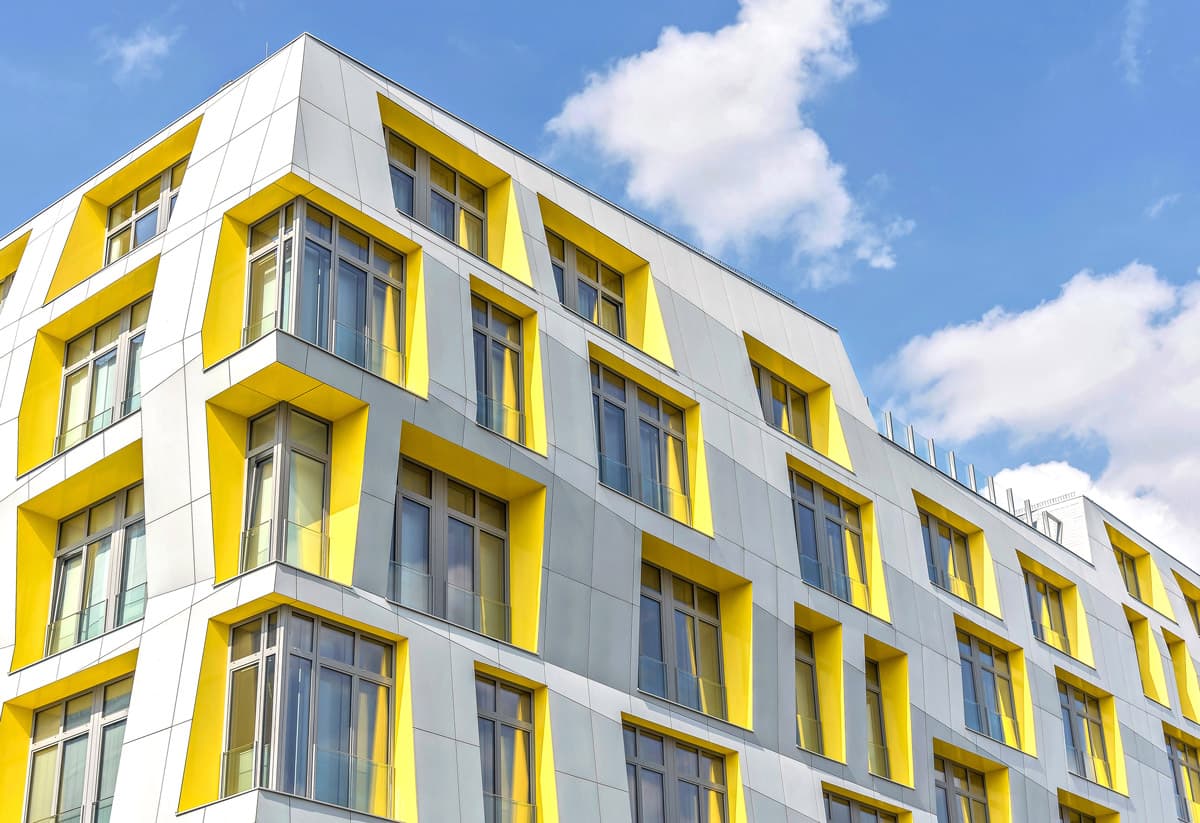
Knowledge

BAFA Subsidy for Heat Pumps 2025: Everything You Need to Know Now
Switch to a heat pump now and get up to €21,000 in subsidies! In 2025, climate-friendly heating is more supported than ever—with up to 70% funding, attractive bonuses, and a digital application process. All you need to know about BAFA funding at a glance.
Continue reading
Renaissance of wall decoration: a brief cultural history of wallpaper
Wallpaper is back: from aristocratic luxury to modern art. It blends nostalgia and innovation, adding character and accents to spaces. With sustainable materials and creative designs, it’s a statement of individuality and style.
Continue reading
Working in Small Spaces: How to Create the Perfect Home Office in an Apartment
Smart working in small spaces: How to create the perfect home office in an apartment – with clever furniture, clear zoning, and ergonomic solutions for more style and productivity in just a few square meters.
Continue reading
How Much Space Does a Family Need? Living Culture Through the Ages
How much space does a family need? Our living culture has evolved: children's rooms, open living areas, and flexibility are in demand. Despite the growing need for space, urban challenges and sustainability remain central questions.
Continue reading
Designing Sustainable Homes: Constructive Ideas for More Environmental Awareness
Sustainable living without major renovations? With smart technologies, eco-friendly materials, and clever ideas, you can enhance comfort while reducing your ecological footprint. Simple measures for an environmentally conscious home.
Continue reading
Green living: The positive effects of biophilic design for your home
Natural living for greater well-being Biophilic design - the integration of natural elements into living spaces - is more than just a trend today. This approach improves the ambience, increases well-being and has a positive effect on productivity.
Continue readingHome & Living

City, countryside, flat or house? These are the home and living trends in German housing
While we all need a place to live, there are any number of ways to make yourself at home. On the one hand, housing is a basic need, but at the same time, it is also extremely personal. There is a huge variety of different housing concepts, and picking your residential format and lifestyle involves any number of decisions.
Do you want to live in the city or out in the countryside? Do you prefer to rent or to own your home outright? Do you love to spread out or wish to use as little space as possible? Do you live alone or share your home? How much money are you willing and able to spend for accommodation? And how would you like to decorate it? The decisions to may keep getting smaller in scale until eventually you find yourself pondering the colour of the bathroom rug and the features of your refrigerator.
You will agree that there is no end to topics to discuss when it comes to housing trends. Below, we would like to bring you an overview and some background information that we believe will make at least some of your decisions around the subject of home a bit easier. Let us start with the question what is more rewarding: renting or buying? Next, we will take a look at the statistics to find out about how other people in Germany live. Finally, let us give you some tips on nice and clever ways to decorate your home as well as on ways to save money around your home.
All articles
- BAFA Subsidy for Heat Pumps 2025: Everything You Need to Know Now
- Working in Small Spaces: How to Create the Perfect Home Office in an Apartment
- Designing Sustainable Homes: Constructive Ideas for More Environmental Awareness
- Renaissance of wall decoration: a brief cultural history of wallpaper
- How Much Space Does a Family Need? Living Culture Through the Ages
- Green living: The positive effects of biophilic design for your home
- Future-proof living: How smart cities are revolutionizing living!
- Barrier-free living space - what makes it accessible and where mistakes happen
- Green light for smart meter roll-out
- Noise Nuisance – How to Deal with Noisy Neighbours
- Does it Make Sense to Take out a Small Loan for Refurbishment Work?
- Modern, Shabby, Hygge? Make way for Lagom. But what is it all about?
- Insulating attic or roof? – Check out our tips right here!
- Christian Democrat Block Carried the Day: Tenants to Pay for Carbon Levy
- Rental Growth Slowing a Bit
- Steady Decline in Flats in Detached and Semi-Detached Homes
- Germany’s Housing Supply Increases Despite Coronavirus Crisis
- Residential Rent Growth Despite COVID-19
- German Real Estate Keeps Trending Internationally, too
- Residential Floor Space Consumption on the Rise
- German Housing Market the Most Desirable Investment Target in Europe
- Rapid Rise in Condo Prices Continued in 2019
- Number of Private Households Likely to Keep Rising
- Steady Increase in Single-Person Households and Micro-Apartments
- Younger Households Go for Homeownership Less and Less Often
- Housing Comparatively Affordable in Germany
- No Relief for the Housing Market
- Affordability of Residential Real Estate Remains on High Level
- Rent Freeze May be Extended
- Condominiums: Price Growth Continues but at Slower Pace
- Declining Number of First-Time Buyers in Germany
- Living in a Condominium is Far more Affordable than Renting a Flat
Table of Contents:
Renting or buying: Which is more rewarding? 1.1 Current rent rates 1.2 Conclusion: a matter of living circumstances
This is how Germans like to live 2.1 Detached home, flat or micro-apartment? 2.2 Period building, new-build, sustainability? 2.3 Office in your private home?
My home is my castle: How to make your home look nice 3.1 Let your home go green: plants for everyone 3.2 Light up your home: picking the right kind of lamp 3.3 Let your place be smart: innovative technology
Renting or buying: Which is more rewarding?
If you answer the question by citing financial aspects only, owner-occupancy will come out on top. Because if you own residential property and live in it, too, you benefit from a variety of cost advantages, according to the ACCENTRO Homeownership Report 2021, aside from not having to pay rent: Buying real estate is considered a very hands-on way to invest your money—especially in times like these—and a great way to build wealth. Residential property prices in German cities have followed an unchecked upward trend for years, so that you will almost certainly be able to sell your house or apartment for more than you paid for it.
Particularly when considering retirement and the financial planning for it, buying property has distinct advantages. Once your home is paid off, your overhead during retirement will be down to service charges and maintenance costs. Compared to the costs of renting, owner-occupancy comes with substantial cost advantages that will contribute in no small way to your pension plan.
From a financial angle, the acquisition of residential property and subsequent owner-occupancy are by all means rewarding. However, it is not necessarily the optimal solution for everybody. Because rental apartments have perks of their own: Especially for those who appreciate freedom and flexibility and whose plans includes places other than Germany, tying yourself to an apartment for longer than the notice period of three months makes little sense.
But not just your own living circumstances might change. Sometimes external factors in the immediate surroundings can change as well, such as noisy neighbours moving in or large-scale construction works starting next door. If you feel that changed conditions are more than you are willing to accept, it is relatively easy and uncomplicated for you as tenant to opt for a change of scene by moving elsewhere.
Renting can even have financial advantages: Living in a rented home requires no equity capital, and there is no need to borrow – or at least not to pay off a mortgage. Many are so wary of the prospect of having to make payments over years and decades that the long-term financial benefits of homeownership pale by comparison. Moreover, you do not bear sole financial responsibility for your dwelling as a tenant. In most cases, the costs of a property’s upkeep, maintenance and repairs fall on the owner.

Current rent rates
If you take a look at the latest rental price trend, the idea of homeownership gains even further in appeal. Rents are on the rise, and they are rising everywhere in Germany. The pace of the rental growth differs among regions and from one city to the next. Housing has become particularly pricey in the economically strong conurbations and in campus towns. The most conspicuous example is Berlin. According to a survey from 2020 that examined the rent rates of 79 cities with populations of more than 100,000 over a ten-year period (2010 through 2020), rents in the German capital rose by 112 percent during the period under review. In Munich, which has reliably topped the German rent index for many years, rents increased by 69 percent over the same period, while Würzburg registered a 60-percent growth. The slowest rental uplift was registered in the cities of Salzgitter, Hagen, Halle an der Saale, Remscheid and Chemnitz – but even here, rents increased at rates of 13 to 20 percent.
The eastern states remain the most affordable region in Germany, especially rural areas. The highest rents are paid in the metropolises of Munich (19.58 €/sqm), Frankfurt am Main (16.23 €/sqm) and Stuttgart (15.23 €/sqm).For a long time, living in the so-called gravy belt was a viable alternative for those wishing to remain within easy reach of the city. But lately, the suburbs and wider metro areas of many German cities have become nearly as popular and expensive as the cities proper.
The sky-high rents charged in Munich are no longer limited to the inner city but have spread far and wide and are felt all the way in Augsburg and Rosenheim. Analogously, the rent hikes of Berlin are matched in nearby Potsdam, those of Hamburg in Lüneburg.

Conclusion: a matter of living circumstances
So, does a look at the latest rent index justify the statement that home-buying is the better alternative to renting after all?The answer, while affirmative, comes with the caveat that prices are going up in sync with rents. Then as now, both models have their pros and cons. Ultimately, it remains a deeply personal decision whether to rent your home or to buy it for subsequent owner-occupancy. It should by no means be made solely on the strength of financial arguments but should always also consider the personal living circumstances and long-term plans. That either residential format has its distinct set of benefits is illustrated by the current distribution of tenants and owner-occupiers in Germany: More than half of all people (54 percent) rented their homes, while 46 percent owned theirs outright.
If you have the necessary equity capital and are willing to commit yourself to a property for the long term or if you are generally interested in the subject, check out our detailed information about real estate buying here.
This is how Germans like to live
Whenever the subject of Germany’s housing trends comes up, the discussion will, of course, not limit itself to the question whether to rent or to buy. After all, there are various choices to consider: period building or new-build unit? Single-living, sharing with your partner, or cross-generational cohabitation? Ample space for spreading out or keeping it at a bare minimum?

Detached home, flat or micro-apartment?
In 2019, the number of households in Germany totalled 41.5 million, home to 82.8 million household members. Statistically speaking, this translates into 1.99 persons per household in 2019, a figure that continues the trend toward ever smaller households which started as early as the 1950s. In fact, the single-person household has been the most common residential format in Germany for the past four decades, and even the number of two-person households is in decline. The number of multi-generation households is plummeting – their share of the total now down to 0.5 percent.
By the end of 2020, the total number of apartments in Germany equalled 42.8 million. Slightly more than half of these were located in multi-family houses of three to ten units. Roughly a quarter of all Germans lived in larger blocks of flats, one third in single-family detached homes or semi-detached units. The average dwelling size was 94 square metres while the number of rooms was 4.4 on average, so that each member of the household occupied an average space of 44.6 square metres.
The costs of residential accommodation can be broken down to a simple formula: the larger, the more expensive. As a result, a new residential format has been gaining ground in urban areas, especially among young people: Living on very small footprints in so-called tiny houses or micro-apartments. Apartments or houses of this type require extremely careful planning because their inhabitants usually have only 15 to 45 square metres at their disposal. But in combination with a minimalist lifestyle, it is a forward-looking concept – especially in times of growing rent rates and housing shortages.
Period building, new-build, sustainability?
Another question that presents itself when you start looking for a home is: period building or new-build unit? In terms of sustainability, the answer is unambiguous: As handsome and stylish as period buildings with their tall ceilings and single-glazed wood-frame windows may be – period buildings tend to have a sustainability and energy efficiency profile that can be three times worse than modern new buildings.
While this has consequences for the heating bill of the individual resident, it should also be in the collective interest of society to make buildings as carbon-neutral as possible. After all, the climate and its progressive change affects all of us. To achieve the climate protection targets of the German Government, the buildings sector will have to play a key role. The German housing stock is supposed to be carbon-neutral by 2050. According to the ACCENTRO Homeownership Report 2021, it is a feat that would require 1.3 trillion euros in investments. Property owners have particularly sound reasons to look into the possibilities and advantages of energy refurbishments. Even the furnishing and interior fit-out of your apartment present opportunities to enhance sustainability, e. g. by opting for “green furniture” and re- or up-cycled home decor.

Office in your private home?
The trend toward minimalism at least among certain generations and societal groups coincides with another trend that has gained increasing significance lately, particularly over the past two years: The need for a separate room to serve as study. Although many employees have returned to their offices, working from home has become much more widely accepted since the COVID19 pandemic, and will probably become an established part of working life for many employees. A prerequisite for undisturbed and productive work from home is to have a sensible workplace, ideally in a separate study.

My home is my castle: How to make your home look nice
Speaking of the coronavirus pandemic: During the past two years, the majority of people spent more time within their own four walls than rarely ever before. Without the option to go to the office, cinema, restaurant, gym or indeed anywhere else, they found themselves spending inordinate amounts of time at home. Never before had it been as important to actually feel at home in your quarters as during the global pandemic. Predictably, the situation triggered a trend to redecorate the home to ensure a feel-good ambience.

Let your home go green: plants for everyone
Having greenery in your home is nice for a number of reasons. Not only are plants pleasant to look at, but they also purify the air, improve your health and night-time rest, and can even prevent allergies. In fact, there is scientific evidence that the green colour of plants mitigates stress and enhances your well-being.
Perhaps you, too, count among those people who love the idea of a green home but do not feel competent enough to take proper care of them? If so, there is no need to worry! There are plenty of plants that are suitable for novice gardeners and people without green fingers.
The magic formula for those who find little time for watering: succulents and cacti. Either species is available in a variety of sizes, shapes and colours. Here is what they have in common: They need very little water and are able to go without for a few weeks if they have to. This makes them the ideal kind of plant for people who spend a lot of time on the road – or simply forget to water their plants on a regular basis.
Have you refrained from getting indoor plants because you fear that your apartment or house lacks light? We are here to tell you that it is just a matter of choosing the right plant. Of course, it is principally correct to say that plants need light and water to thrive. However, there are plenty of species that require very little water and others well suited for dark corners. These include, for example, the emerald palm, the snake plant (by the way, these two get by on very little water) or devil’s ivy. You see: Even a seemingly dark home can be turned into a veritable urban jungle.
Light up your home: picking the right kind of lighting
Lamps are a touchy subject: It is not uncommon to find naked light bulbs dangling from the ceiling weeks and months after the move-in date because the new residents have been unable to find just the right sort of lamp.
A sensible way to start when hunting for the right lighting is to clarify what kind of light you would like in each room, and what a given source of light is expected to do. Generally, it is safe to say: Warm and indirect light makes rooms cosier and slightly smaller than they are, whereas bright and direct light will open rooms up while giving them a cooler ambience. A good idea for living rooms and bedrooms, for instance, is to combine several sources of light, such as floor lamps, wall lights, side lamps and fairy lights. In the study, it can make sense to install a ceiling light with daylight function to ensure you have the optimal lighting conditions for reading and working.
Speaking of natural light: If you crave more natural light in your home, a clever arrangement of mirrors throughout your apartment will often brighten it and even make it look larger.
But more and more lights now come with a so-called daylight mode, which simulates the colour temperature of natural light. Another feature of modern lamps is a dimmer that lets you control the brightness to suit the situation. This can come in handy in the case of an eat-in kitchen, for instance. Here, you will want bright light for preparing, cutting and cooking but may prefer a more subdued light and a cosier atmosphere when sitting down to have dinner.

Let your place be smart: innovative technology
But not just lights offer more and more features. In the case of so-called smart homes, state-of-the-art technology enhances your home amenities and makes your day-to-day life easier. The centrepiece of any smart home is the control centre, operated via smartphone, tablet or desktop computer. Smart devices can be wirelessly connected to your smartphone and operated on the go, any time of day.
How exactly does smart home technology make your life easier? Imagine you are running late one morning but still find your coffee in the kitchen just the way you like it. A pre-programmed and smart fully automatic coffee maker will serve your favourite hot beverage right on time. A motion detector in the hallway will note that you are about to leave the house and will open the linked garage door for you. If you were in a rush and forgot to turn off the light, the heating or the radio, just use your smartphone to do so later. Just before leaving the office, you start the washing machine, lawn mower and vacuum cleaner at the touch of a button so as to return to a tidy home after a busy day at work. In the same way you turned off the lights and the heating from afar, you now turn them back on when on your way home, returning to a heated, well-lit place.
You may also use smart home technology to increase the security of your home. Choose any of various sophisticate systems that use CCTV, access control and smart alarm systems to protect yourself from burglars as well as from water and fire damage. That being said, the security subject is also highly relevant for the smart home system itself because its installation will expose you to the threat of digital burglaries. Before commissioning a smart home system, you should definitely familiarise yourself thoroughly with the subject and associated security threats. In addition, safety packages by specialised insurance companies can help you protect your smart home against hacker attacks.

Carefree living: How to cut costs
To get back to our opening remarks: Regardless of whether you rent or owner-occupy your home, housing always generates costs, and often higher costs than we expected. It always makes sense to check where and how you can save on the overhead at home.

Luckily, there are a number of ways to do so: If you live on your own and would like to pay less for accommodation, you may want to change the costly arrangement. Generally, it is safe to say: The higher the number of persons per household, the lower the per-capita costs. Sharing a home lets you split service charges and extra costs such as for phone and broadband access or the German radio/TV fee (GEZ). While the electric and heating bills will indeed go up when several persons live in your household, they will surely not double or triple. You can also earn cash money by letting your basement, attic or parking spot in the car park to someone else if you have no need for it.
And you can save significant amounts when it comes to service charges. Efficient heating and airing pays off: Opening the windows wide for short spells at a time is much better than keeping your windows tilted. Try to save water and upgrade your apartment and your household appliances above all. Especially as far as power consumption goes, newer energy-efficient devices make a big difference. But you can also save electricity with your legacy appliances, for example by switching them off completely instead of just putting them in standby mode or by unplugging them when not in use.
Ask yourself before signing up for broadband access which rate and data speed you need. Will you be paying for a landline connection you won’t actually use? You should take the same approach with insurance policies: You will definitely need a private liability and a household insurance, but any other type of insurance concerning house or apartment is optional, and it is up to you to decide which risks you want to defuse. For all broadband services, insurance policies and utilities, there are great online comparison portals that will help you find the best rates for your needs.

Conclusion
The subject of lifestyle trends is inexhaustible, and there is simply so much to decide: where to live, and with whom, how much you are willing and able to pay for an apartment or a house, how much space would be plenty and how much too little, how to cut costs, and so much more. But during all the decision-making, especially in financial matters, please do not lose sight of the fact that you should enjoy your future dwelling and that you will want to live a good life in it. With this in mind: Make yourself at home!

For these and other topics involving real estate, browse our knowledge blog at: https://accentro.de/en/knowledge

Working in Small Spaces: How to Create the Perfect Home Office in an Apartment
Smart working in small spaces: How to create the perfect home office in an apartment – with clever furniture, clear zoning, and ergonomic solutions for more style and productivity in just a few square meters.
Continue reading
How Much Space Does a Family Need? Living Culture Through the Ages
How much space does a family need? Our living culture has evolved: children's rooms, open living areas, and flexibility are in demand. Despite the growing need for space, urban challenges and sustainability remain central questions.
Continue reading
Barrier-free living space - what makes it accessible and where mistakes happen
Housing should meet the needs of as many people as possible. The more accessible homes on the market, the better. But not every property that is described as barrier-free actually is. Our new blog post provides clarification.
Continue reading
Does it Make Sense to Take out a Small Loan for Refurbishment Work?
Regardless of whether it is a tenant-occupied apartment or your own home: Every residence needs to be fixed up from time to time so as to make sure it retains its quality of living and its property value.
Continue reading
Designing Sustainable Homes: Constructive Ideas for More Environmental Awareness
Sustainable living without major renovations? With smart technologies, eco-friendly materials, and clever ideas, you can enhance comfort while reducing your ecological footprint. Simple measures for an environmentally conscious home.
Continue reading
Green living: The positive effects of biophilic design for your home
Natural living for greater well-being Biophilic design - the integration of natural elements into living spaces - is more than just a trend today. This approach improves the ambience, increases well-being and has a positive effect on productivity.
Continue reading
Green light for smart meter roll-out
Smart meters can help consumers keep better track of their energy consumption and save on electricity costs at the end of the month. Here you can find out exactly what they are and what consumers will have to face in the future.
Continue reading
Modern, Shabby, Hygge? Make way for Lagom. But what is it all about?
Modern, stark, discreet and casually minimalist. This, in a nutshell, give you a general idea of the latest Nordic living style.
Continue reading
Renaissance of wall decoration: a brief cultural history of wallpaper
Wallpaper is back: from aristocratic luxury to modern art. It blends nostalgia and innovation, adding character and accents to spaces. With sustainable materials and creative designs, it’s a statement of individuality and style.
Continue reading
Future-proof living: How smart cities are revolutionizing living!
Smart cities are changing the way we live Smart cities are revolutionizing the way we live - through more efficient, connected and sustainable technologies. But how do you benefit from this as a homeowner?
Continue reading
Noise Nuisance – How to Deal with Noisy Neighbours
Pets, loud music or vacuum-cleaning – there is a long list of household sounds that can create a noise disturbance and cause disputes among neighbours.
Continue reading
Insulating attic or roof? – Check out our tips right here!
Whether as storage area, play room or extra bedroom – depending on how you intend to use your attic, insulating the roof or the top floor ceiling is not only rewarded by cost and time savings, but is also good for the environment.
Continue reading